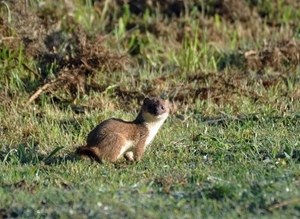Stoat (Mustela erminea)
 Whenever I see a stoat, I can’t help but think - where do you get all that energy from? They always seem to be constantly on the move, rushing around seemingly without a second to spare. Stoats have a long, slim body with relatively short legs and a tail that always has a black tip. Even when some of the more northerly-based stoats change their coat colour from a reddish brown to white or partial white in winter (known as 'ermine'), they still hang on to the black-tipped tail.
Whenever I see a stoat, I can’t help but think - where do you get all that energy from? They always seem to be constantly on the move, rushing around seemingly without a second to spare. Stoats have a long, slim body with relatively short legs and a tail that always has a black tip. Even when some of the more northerly-based stoats change their coat colour from a reddish brown to white or partial white in winter (known as 'ermine'), they still hang on to the black-tipped tail.
This is a sure-fire way of differentiating stoats from their close cousin, the weasel, which has no black tip to the tail and is, of course, much smaller than a stoat. In the past a stoat’s white “ermine” coat was a prized possession, used as the traditional trimming for the robes of royalty and the Lord Chief Justice.
A female stoat is usually called a bitch and the male a dog but other names are sometimes used. The young are called kits or kittens and a group of stoats is called a caravan, although both gang and pack are also used. Springtime sees the only litter of the year being born, with between six to twelve blind, deaf, toothless kits, their bodies covered in a fine white down, huddled together in a fur-lined nest. The female was mated the previous summer, but delayed implantation of the fertilised eggs for some nine to ten months means that she has technically carried the offspring for nearly a year. The actual gestation period is only four weeks long!
What I find truly amazing is that, quite often while the bitch stoat is away hunting, a dog stoat may sneak into the nest site to mate with the tiny female kits, which have changed little from the time that they were born and yet have become sexually mature at the unbelievably young age of only two or three weeks old, long before they are even weaned!
The stoat is a fantastically skilful predator that can climb trees to raid bird nests, squeeze down and through all sorts of holes and entrances to look for small mammals and has endless amounts of stamina to chase larger prey. Their eyesight is, however, not quite as good as ours (though better than human sight in the dark), so scent plays an important role when pursuing a victim.
When it comes to catching rabbits, they have two different approaches. Sometimes they will enter a field with plenty of rabbits and start a strange dance that weaves, jumps and snakes its way across the field towards their prey. The rabbits appear fascinated by these movements and become almost mesmerised, until one of them allows the predator to come too close… and that is that.
The other tactic is simply to chase the rabbit relentlessly to wear it down until it literally comes to a halt. Stoats can run at speeds of up to 20 miles an hour and once they have decided on which individual rabbit to hunt, they mercilessly follow its scent, often closely passing other watching rabbits, who appear to know that it is not they that are the quarry on this occasion! Eventually the pursued rabbit seems to almost “seize up” through a combination of exhaustion and fear, so that the stoat can jump onto the back of its prey and bite into the neck. Astonishingly, they can kill rabbits which are ten times their own size – now that is some killer!
The stoat’s one downfall is its incessant inquisitiveness. Many a young apprentice gamekeeper will have been taught how to “squeak” out a stoat. It may have disappeared into dense cover, but by sucking on the back of the hand to create the sound of an animal in distress, the blood thirsty little creature cannot resist the temptation to come back out to investigate what is making the noise.
Finally, I just want to share with you the meaning behind the nursery rhyme Pop goes the Weasel. In Cockney rhyming slang, weasel and stoat means coat, and if you popped something, you pawned it. What used to happen was that Cockneys frequently went into the Eagle pub, situated on the corner of Shepherdess Street and City Road, in the Shoreditch area of London. Many a good “session” was had and they often spent far too much money enjoying themselves – so much so that they then had to go down to the pawnshop to literally hand over the coat off their backs! The pub still has a wall plaque telling you all about it. This is how the third verse goes:
Up and down the City Road,
In and out the Eagle,
That's the way the money goes;
Pop! goes the weasel.
Peter Thompson
Advisory
Read more from Peter Thompson at the Fresh from the Field blog.

Download Peter Thompson's essential 26-page book, featuring beautiful photography and detailed profiles of Britain's wildlife
Download FREE >